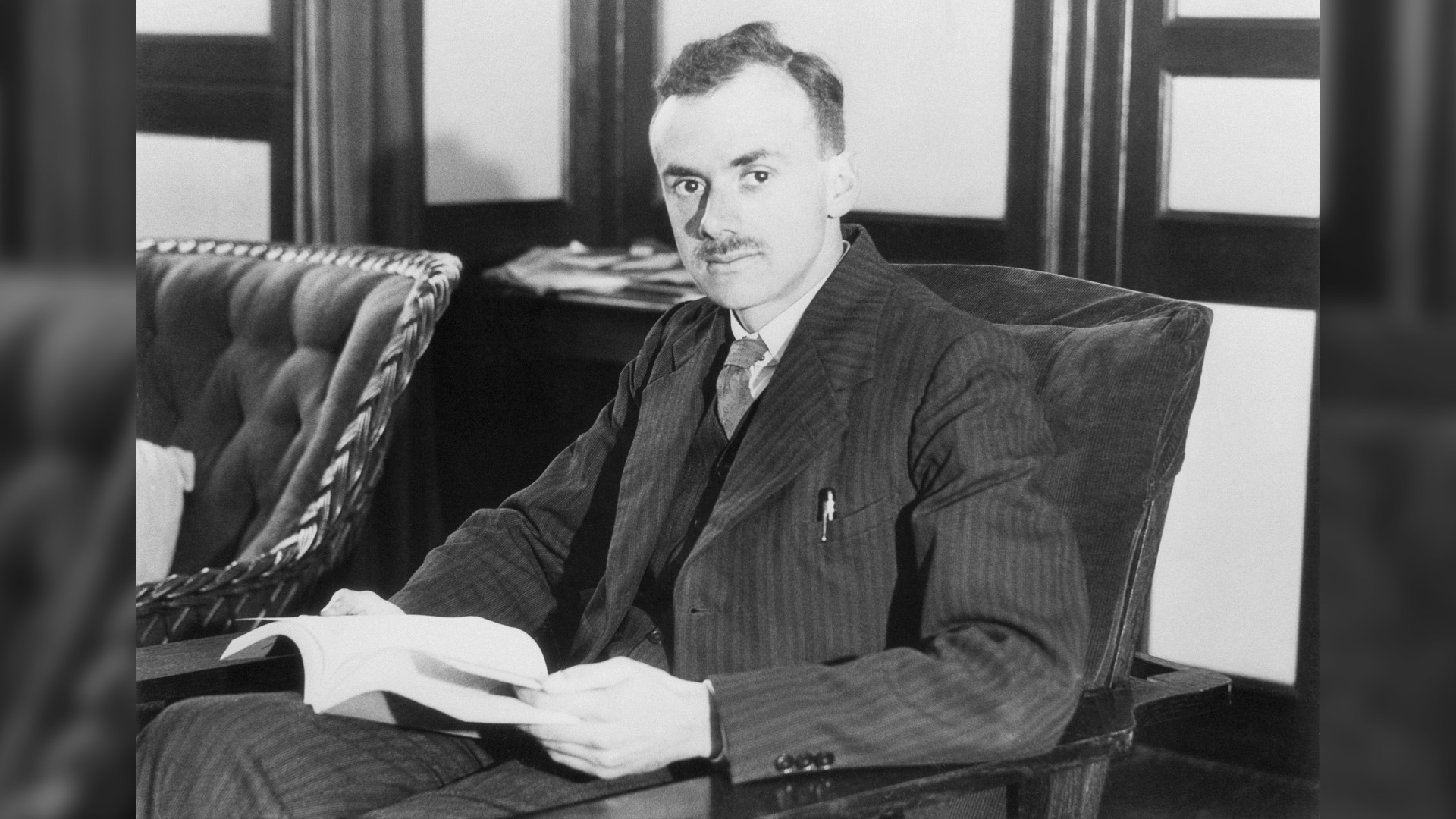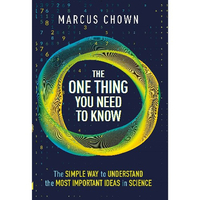'The most magical equation in physics': How Paul Dirac accidentally revealed the strange world of antimatter
"Of all the equations of physics, perhaps the most magical is the Dirac equation."

British theoretical physicist Paul Dirac was one of the most significant figures in the early days of quantum physics, who along with Erwin Schrödinger won the Nobel Prize for physics in 1933. But it was in 1927 that this quiet, but brilliant mind set to work looking for "pretty mathematics," and in doing so formulated what would become one of his greatest achievements — the Dirac equation.
In this extract from the Antimatter chapter of his book "'The One Thing You Need to Know'," author Marcus Chown explains how Dirac's unusual methods and mannerisms helped guide us towards understanding the fundamental physics that forms the world around us.
Related: What is antimatter?
Nature has chosen to double the number of its basic building blocks. For every subatomic particle, remarkably there exists an "'antiparticle"' with opposite properties such as electric charge. Before 1927, nobody had the slightest suspicion that such a world of "'antimatter"' existed. But that year, the British physicist Paul Dirac wrote down an equation that described an electron travelling at close to the speed of light and noticed that it contained something odd.
Dirac was one of the pioneers of quantum theory, the revolutionary description of the submicroscopic realm of atoms and their constituents. The theory reconciled two seemingly contradictory characteristics of the world revealed in experiments in the first quarter of the twentieth century: the ability of atoms and their like to behave both as localized particles and as spread-out waves. In 1926, the Austrian physicist Erwin Schrödinger encapsulated this in the Schrödinger equation, which describes quantum waves of probability spreading through space.
The problem with the Schrödinger equation is that it does not incorporate the other revolution of twentieth-century physics. In his special theory of relativity of 1905, Einstein showed that strange things happen to space and time as a body with mass approaches the speed of light. Although the Schrödinger equation works fine when describing an electron in a small atom, where the electric force of only a handful of protons in the nucleus causes it to orbit at much less than the speed of light, in heavier atoms, where there are lots of protons in the nucleus and an electron is whirled around at close to the cosmic speed limit, the equation breaks down. What was needed was an equation that was compatible with the special theory of relativity — relativistic — and that was what Dirac set out to find.
Dirac was a strange man who today would probably be diagnosed as being on the autism spectrum. Tall, gangly and reminiscent of a stick insect, his habit was to work hard all week and on Sundays take long walks in the countryside around Cambridge, where he would climb tall trees dressed in his suit and tie. Literal to the point of obtuseness, he was the Mr. Spock of physics. When a student put up their hand during one of his lectures and said, "'Professor Dirac, I don't understand the equation on the blackboard," he replied: "'That's a comment not a question'," and continued with his lecture.
Sign up for the Live Science daily newsletter now
Get the world’s most fascinating discoveries delivered straight to your inbox.
Dirac's approach to physics was no less strange than his character. Whereas other physicists sought everyday analogues of the phenomena they wanted to describe, which they then tried to encapsulate in a mathematical equation, Dirac had the courage to simply sit with a pen and paper and guess at the form of an equation. "It's a peculiarity of myself that I like to play about with equations, just looking for beautiful mathematical relations which maybe don't have any physical meaning at all," said Dirac. 'Sometimes they do.'
'Of all the equations of physics, perhaps the most magical is the Dirac equation'
American physicist Frank Wilczek
It was while looking for "pretty mathematics" in his spartan rooms at St. John's College in late November 1927 that Dirac literally plucked from thin air what would become known as the Dirac equation. Today, it is one of two equations inscribed on flagstones on the floor of London's Westminster Abbey. The other is Stephen Hawking's equation for the temperature of a black hole. "Of all the equations of physics, perhaps the most magical is the Dirac equation," says American physicist Frank Wilczek (in the book "It Must Be Beautiful: Great Equations Of Modern Science" by Graham Farmelo (Granta, 2003)). "It is the most freely invented, the least conditioned by experiment, the one with the strangest and most startling consequences."
Dirac had found it impossible to describe a relativistic electron's properties, such as its energy, with a mere number, so instead had to use a two-by-two table of numbers known as a matrix. This "two-ness" explained a puzzling feature of the electron. Experiments had revealed that the particle behaved as if it was spinning in one of two ways: clockwise or anticlockwise. However, if an electron was really spinning, its behavior could be understood only if it was spinning faster than light, which, according to Einstein, was impossible. Physicists were forced to conclude that the "spin" of an electron was something entirely new. It was an intrinsic quantum property with no analog in the everyday world. And here it was, Dirac saw, just popping unbidden out of the formula he had written down. "My equation gave just the properties one needed for an electron," said Dirac. "That was really an unexpected bonus for me, completely unexpected." According to the American physicist John Hasbrouck Van Vleck, Dirac's explanation of an electron's spin was comparable to "a magician's extraction of rabbits from a silk hat."
Spin was strange. But another aspect that emerged from Dirac's equation was even stranger. When Dirac wrote down his equation, he noticed that its machinery was oddly duplicated. It appeared to describe not only a negatively charged electron, but also a particle with the same mass as an electron that had a positive charge. At the time, only three subatomic particles were known: the proton in the nucleus of the atom; the electron, which orbited the nucleus; and the photon, the particle of light. There appeared to be no need for another one. Even the great physicists of the day such as Werner Heisenberg and Wolfgang Pauli thought that the Dirac equation must be wrong. However, Dirac was right and they were wrong, as an experiment 8,000 kilometers away from Cambridge would later show.
In 1932, Carl Anderson, an American physicist at the California Institute of Technology in Pasadena, was trying to understand cosmic rays, extremely high-energy particles from space. He expected them to smash into atoms in the atmosphere, kicking out their electrons. If he could just measure the energy of such ejected electrons, he reasoned, he would have a handle on the energy of the cosmic rays. To this end he used an extremely strong magnetic field to bend the electrons, deducing that if they had high energy and so were moving fast, they would spend little time in the vicinity of his magnetic field and be bent less sharply than if they had low energy and spent more time there.
Anderson made his electrons visible by means of a "cloud chamber." Inside the device, tiny trails of water droplets formed along the tracks of electrons, and he could photograph these trails. On 2 August 1932, Anderson developed a photographic plate and was astonished to see a particle of the mass of an electron that was bent by the magnetic field in the opposite way to an electron. He knew nothing of Dirac's prediction. Nevertheless, he had stumbled on Dirac's positively charged electron, a particle which he immediately christened the "positron."
Excerpted from The One Thing You Need to Know. Copyright © 2023 by Marcus Chown.
Published by Michael O'Mara.
The One Thing You Need to Know: 21 Key Scientific Concepts of the 21st Century - $23.88 on Amazon
If you're interested in science, anything from black holes to gravity, tides to global warming, then you'll want to pick up Marcus Chown's new book. Marcus is a master at communicating about complex science, turning tricky topics into bite-sized explanations that are easy to understand.

Marcus Chown is an award-winning writer and broadcaster. Formerly a radio astronomer at the California Institute of Technology in Pasadena, he is a Royal Literary Fund Fellow at Brunel University. His books include 'Breakthrough,' 'The Ascent of Gravity,' which was the Sunday Times 2017 Science Book of the Year; 'Infinity in the Palm of Your Hand', 'What A Wonderful World', 'Quantum Theory Cannot Hurt You,' 'We Need to Talk About Kelvin,' and 'Afterglow of Creation,' both of which were runners-up for the Royal Society Book Prize. Marcus has also won the Bookseller's Digital Innovation of the Year for 'Solar System for iPad.'











